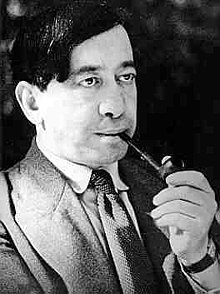Siegfried Kracauer
| Siegfried Kracauer | |
|---|---|

A young Siegfried Kracauer
|
|
| Born |
February 8, 1889 Frankfurt am Main, German Empire |
| Died | November 26, 1966 (aged 77) New York City, United States |
| Occupation | Journalist, sociologist, film theorist |
Siegfried Kracauer (February 8, 1889 – November 26, 1966) was a German writer, journalist, sociologist, cultural critic, and film theorist. He has sometimes been associated with the Frankfurt School of critical theory.
Born to a Jewish family in Frankfurt am Main, Kracauer studied architecture from 1907 to 1913, eventually obtaining a doctorate in engineering in 1914 and working as an architect in Osnabrück, Munich, and Berlin until 1920.
Near the end of the First World War, he befriended the young Theodor W. Adorno, to whom he became an early philosophical mentor. In 1964, Adorno recalled the importance of Kracauer's influence:
[f]or years Siegfried Kracauer read the Critique of Pure Reason with me regularly on Saturday afternoons. I am not exaggerating in the slightest when I say that I owe more to this reading than to my academic teachers. [...] If in my later reading of philosophical texts I was not so much impressed with their unity and systematic consistency as I was concerned with the play of forces at work under the surface of every closed doctrine and viewed the codified philosophies as force fields in each case, it was certainly Kracauer who impelled me to do so.
From 1922 to 1933 he worked as the leading film and literature editor of the Frankfurter Zeitung (a leading Frankfurt newspaper) as its correspondent in Berlin, where he worked alongside Walter Benjamin and Ernst Bloch, among others. Between 1923 and 1925, he wrote an essay entitled Der Detektiv-Roman (The Detective Novel), in which he concerned himself with phenomena from everyday life in modern society.
Kracauer continued this trend over the next few years, building up theoretical methods of analyzing circuses, photography, films, advertising, tourism, city layout, and dance, which he published in 1927 with the work Ornament der Masse (published in English as The Mass Ornament).
...
Wikipedia
